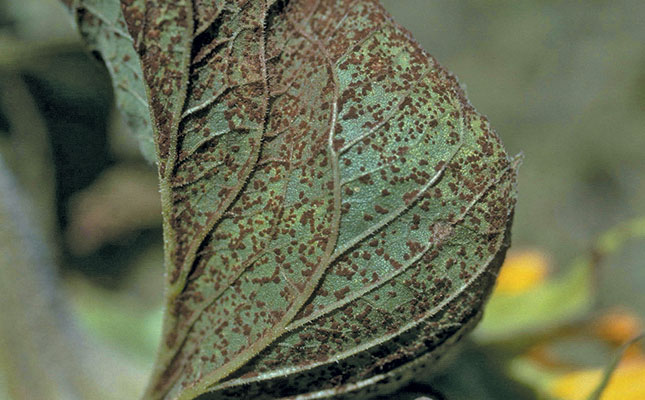
Photo: Howard Schwart
Blight can occur during the growing process if environmental conditions favour it. ARC-Grain Crops Institute surveys have found brown blight in all major sunflower-producing regions in South Africa, particularly in North West and Free State.
Yield losses of between 10% and 40% in each land were seen in the Bothaville, Ottosdal, Vredefort, Kroonstad, Rustenburg, Senekal and Lichtenburg areas during 2015/2016.
Brown blight is caused by the fungus Puccinia helianthi.
This overwinters on plant debris and does not require an alternate host to complete its life cycle. The spores germinate in spring to produce reproductive spores (basidiospores) that infect sunflower seedlings. These can be spread by wind to other plants, infecting the stems, bracts, petioles and leaves.
Several conditions promote the growth of blight:
- Warm temperatures between 12°C and 29°C, and rain, irrigation or dew;
- Dew on leaves caused by low night temperatures during dry years;
- High nitrogen fertilisation and seeding rates, resulting in lush leaf growth, which increases humidity in the canopy.
Symptoms
Blight can be identified by uredial pustules (brown spots), mainly on the leaves. These can also occur on the stems, petioles, bracts and the back of the flower. The pustules on the underside of the leaf turn black when the air temperature decreases.
Control
- Plant blight-resistant hybrids;
- Rotate crops, as this interferes with the life cycle of the fungus;
- Reduce irrigation nitrogen fertiliser;
- Blight overwinters on volunteer sunflower plants, so destroy all such plants near your lands in early spring;
- To limit new infections and prevent epidemics, apply registered fungicides, such as Triazole and Strobilurin, in good time. Seek expert advice before applying chemicals, and keep to the recommended rate and time of application.
Source: Ramusi, M., Flett, B. (2016). Brown rust of sunflower: a potentially devastating disease. ARC-Grain Crops Institute, Potchefstroom.










